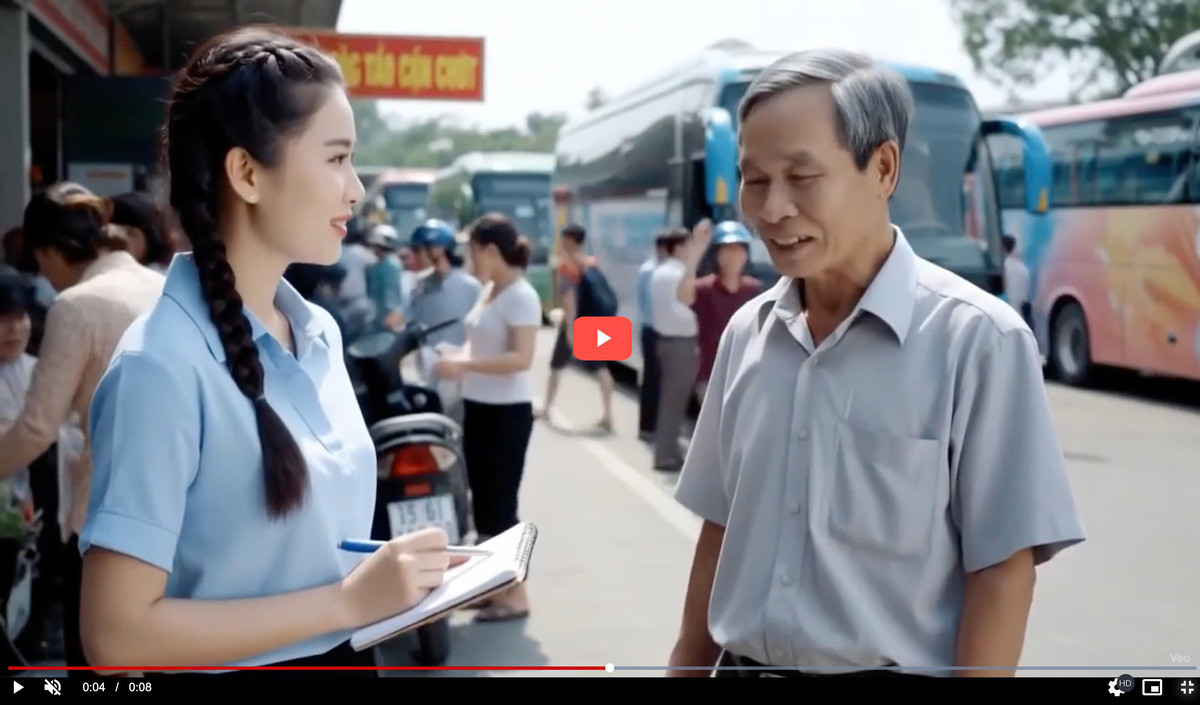
“I initially made a video just to test and catch the trend, but the number of interactions far exceeded all previous ad campaigns,” said Minh, a representative of a transport firm that provides services on the Hanoi - Tuyen Quang route.
It all started with an AI-generated video using Veo 3, showcasing the company’s services and fixed routes.
Since then, instead of posting static images with plain captions, the company’s marketing team has begun crafting scenes, adding music, and leveraging AI to produce cinematic, engaging videos that attract thousands of views and comments.
Cinematic taglines like “The journey doesn’t start at the departure point, but when you choose the right vehicle” or “Do you know which bus company is reliable and safe?” turned simple videos into highly shareable content. According to Minh, daily bookings rose 20 percent within two weeks.
Veo 3’s wave is spreading fast, not only in passenger transport but also among car, accessory and auto interior businesses. At a Hanoi car dealership, every new car model is featured in videos showing it racing on tracks or highlighting showroom interiors. In reality, no filming took place and there was no studio; all were created by Veo 3 using a few images and concept descriptions.
“No need to spend tens of millions hiring crews or studios. With just a few quality images and a decent script, we can produce polished, compelling videos that are in no way worse than professional TVCs,” a staff member revealed.
Nguyen Tuan Anh, the owner of an auto accessory shop, said “each Veo 3 video takes just tens of minutes to make, costs 2-3 times less, while the communication effectiveness is 5-7 times higher than running regular image ads.”
In addition to using Veo 3 to introduce products, Anh also exploits this tool to create virtual demonstration videos, helping customers visualize what the accessories installed in the car would look like.
“We started to create simulated scenes of the car from the outside, matching interior colors as requested, and customers were extremely excited. The number of orders for car interiors increased significantly compared to the previous month,” Anh said.
His shop also keeps up with trends, creating TikTok-style videos narrating car makeover journeys—from receipt to transformation—in 8-30 seconds for each video. These help customers remember the brand better and boost recognition far beyond static images.
From a tool favored by content creators and individuals, Google’s advanced AI video platform Veo 3 is becoming a new weapon in auto marketing. Introduced at Google I/O 2025, it generates high-quality videos from text and images, simulating motion, transitions, music, and lifelike lighting.
With a small investment in a Veo 3 account, Nguyen Van Thien turned wild advertising ideas into reality instantly, generating VND60 million in monthly revenue.
Using just a computer and a few descriptive lines, Nguyen Van Thien, 30, from DongThap, can create professional ad videos without studios, crews, or actors—all powered by Veo 3’s AI in just an hour.
Thien discovered Veo 3 while implementing a social media campaign. Struggling with video production, he tried to find an AI tool and found that Veo 3 could realize 80 percent of his ideas—something traditional production would take a month and cost tens of millions.
“With VEO 3, it's just a matter of experience writing commands so that VEO 3 understands what you want," he affirmed.
However, experts warn that overusing virtual imagery can mislead consumers. “Customers may be impressed by videos, but if reality differs greatly, it backfires. Using AI for marketing doesn’t mean exaggerating the actual product,” Tuan Anh said.
Beyond Veo 3, tools like Runway and Pika Labs are also becoming vital for auto businesses. Soon, virtual showrooms, AI-driven test drives, or even crew-free ad films may emerge.
This trend signals a new phase in auto and motorcycle marketing, where technology, speed, and storytelling are the deciding factors.
Can Veo 3 can replace media professionals? At first, like many in media, Thien believed AI could hardly replace humans due to emotional depth, perspective, and experience. But after experiencing and witnessing Veo 3’s effectiveness, he has changed his mind.
“Maybe Veo 3 can’t fully replace humans now, but as it or other AI platforms mature, traditional roles will likely be replaced and optimized to the fullest,” Thien noted.
Ha Thuong